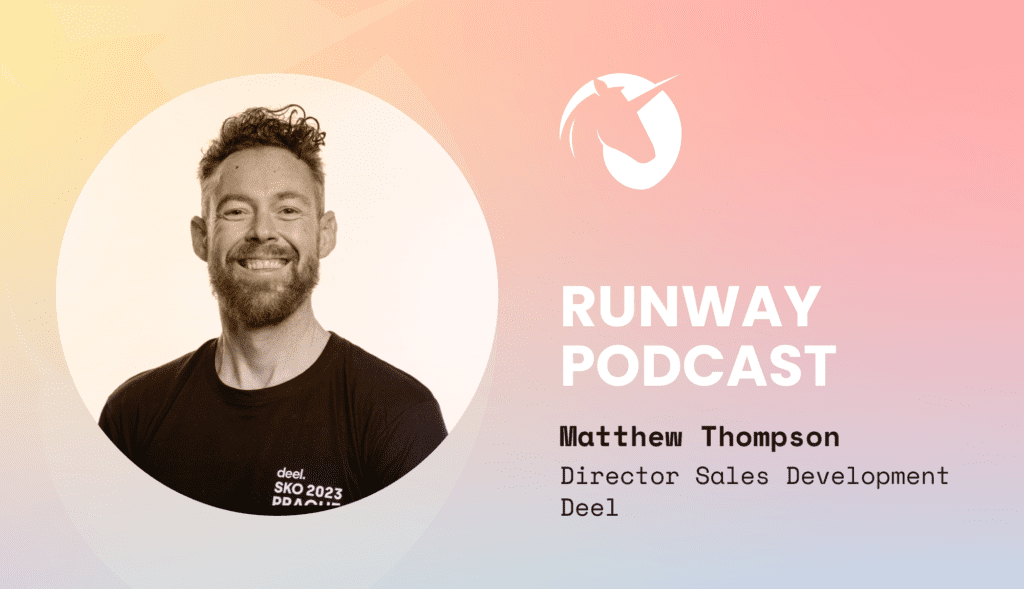In this episode of our podcast, we dive deep into the world of inbound and inside sales with Matthew Thompson, Director of Sales Development for EMEA at Deel. From his early days managing small sales teams to scaling a sales development powerhouse at Deel, Matt shares valuable insights on how to build, grow, and optimize a sales organization.
During the conversation, Matt and Mauro discuss everything from managing leads and structuring teams to hitting ambitious targets and motivating sales teams. Whether you’re an aspiring sales professional, a startup founder trying to build your first sales team, or a seasoned executive looking to scale your sales operation, this episode is packed with actionable advice.
Tune in as Matt shares stories from his journey, tips on personalizing outreach, the critical role of collaboration in sales, and how Deel became one of the fastest-growing SaaS companies in history.
Enjoy the conversation, and don’t forget to check out the full transcript below!
Mauro Battellini: Hello, dear listeners, today you’re in for a sales treat. We’ve got Matt from Deel ready to give us a ton of insight and fun sales stories. Matt Thompson is Director of Sales Development for EMEA at Deel, in case you’ve been living under a rock. Deel is the number one global HR solution, solving hiring and compliance across borders. Deel is the first to do this. It’s a Y Combinator company that raised more than $650 million and is backed by some of the most exciting investors in the world. Matt joined Deel as employee 200, more or less, after various roles leading inside sales teams. When he joined, his team was only three or four people, and he scaled it to a team of 100-plus, transforming it into a well-oiled inbound sales machine. Today, we’ll be mostly talking about inbound sales, but we’ll also talk about inside sales more generally and scaling sales teams. Welcome, Matt. So good to have you here.
Matthew Thompson: Thank you very much, and it’s an honor as well. I feel privileged. Thank you very much for giving me the opportunity.
Mauro Battellini: Yeah, mega awesome to have you here. I can’t think of anyone better to talk about sales or inbound sales with than you. Just a disclaimer for everyone, Matt was my manager at an inside sales role for about two years or so, and in those two years, it was such a huge learning curve. I was lucky enough to be able to manage the team that you left behind, but it was thanks to you and that huge learning curve that I took my first steps in sales. A couple of years later, I found myself overseeing about a million pounds in revenue yearly with a young team of guys, which was all possible thanks to your training, your incentives, the game theory you applied, but also the human approach. I feel like we’re doing a full circle here by having you.
Matthew Thompson: Thank you for such a wonderful introduction, and I’m going to embarrass you slightly by just saying that firstly, it’s a privilege to be here, and an honor to be given this opportunity. But secondly, I think you broke my record as well. So when I took over the inside sales team at Mintel, they hadn’t hit target for, I think, seven years. We managed to get to target in year two. Then we got to 107%, and then you destroyed my record—a testament to your skill set. Mauro, you were always one of the top performers as well. So I’m not surprised, I’m not surprised. So congratulations on that, sir.
Mauro Battellini: Thank you.
Matthew Thompson: Thank you.
Mauro Battellini: I can’t take full responsibility for that. You laid the foundations for that. Really, all we had to do was maintain. But okay, with this little intro done, let’s go back to the subject of today and let’s start with your story. So we’re going to talk about inside sales or inbound sales—we’ll clarify that later—but first, let’s get to know you a bit better. So what’s the story of Matt Thompson? How did you even get into sales? What was your sales journey, so to speak, and how did you end up managing a team of 100-plus at Deel?
Matthew Thompson: I started working as an account executive and managing a small quota, then building up into business development, then into an account manager. I really wanted to transition into management, and Mintel was the first real role. I guess Mintel, Splunk, and Deel will be the companies that we talk about today. Mintel was the head of inside sales, and taking a team that hadn’t hit target for a long time and getting them there with the help of yourself and a talented bunch of fun individuals that we worked with. Then there was Splunk, which was my first toe into tech sales. So I was managing the inside sales team for the Middle East and Africa, but also building out a commercial business development team. That would be for companies with revenue under $1 billion, and that was for EMEA. And then Deel, which has been the fastest-growing SaaS company in history at the moment. I was employee number 200, taking a bit of a risk going there, but it was a calculated risk. The innovation is so strong that now we’re at 4,500 employees. The team I inherited had four individuals, and we’ve grown it to 150-plus at the moment. Currently, they generate 40% of all the opportunities created by the whole organization—from marketing, partnerships, and sales development. So that’s everything in a nutshell.
Mauro Battellini: Let’s go back to the basics before we look in detail at your experience at Deel—how you grew the team and how you’re getting the team to convert all those opportunities. Let’s go back to what sales is. Because in the pod, we have a lot of startup people listening, and one of the first things for founders to understand is that they need to do sales. A lot of founders don’t want to do sales, coming from a product or finance background, and so on. But they don’t even know what sales really is. A lot of them think it’s maybe something a bit like a used-car salesman type of thing, where it’s pushy and annoying. They don’t know the difference between the different types of sales—inside sales, outbound sales, and so on. So if we can take a helicopter view, can you just describe how sales is structured in an organization?
Matthew Thompson: It’s a brilliant question, and I love what you just said there, Mauro. People do see sales as pushy, as if we’re in it for ourselves, like that used-car salesman stereotype. That’s not modern sales today. You need to be consultative, strategic. It’s all about personalization, focusing on the individual. It’s not about us, our company, and how great we are. It’s about the individual—the challenges and pains they face. It’s important to lay down how vital sales is for a business, and that it’s completely different from that old-school, archaic persona.
Inside sales and sales development are fundamental functions in a business these days, and it’s evolved a lot. When we were at Mintel, that was around 10 years ago—showing our age, but inside sales back then was taking the pressure off the account executives so they could focus on their sales funnel and closing big, complicated deals. Inside sales would run the full sales cycle, but for smaller, more transactional deals. Over time, this changed, and you’d have sales development and business development—BDRs and SDRs. Their role is to let account executives focus on closing deals and current pipeline, while the SDRs focus on new opportunities and generating qualified leads for the AEs.
The last point I’ll make is that inside sales is crucial as it gives insight into the market. You have your ear to the ground on challenges and opportunities. It’s a huge part of all organizations and startups.
Mauro Battellini: You mentioned you were employee 200 at Deel. How big was the sales team when you got there? What did you find yourself with? My next question would have been—what do you need to start an inbound sales team? You need leads, good marketing, a product that attracts interest—hence, inbound sales. What kind of infrastructure do you need to create an inbound sales team? And before there’s an inbound team, what sales teams would you typically find? Would there still be an inside sales team trying to do the whole process?
Matthew Thompson: When I joined, we had account executives but no inbound or inside sales teams. We had four SDRs—just to clarify, BDRs and SDRs are the same thing, depending on the company. These four individuals had no training, were using personal laptops, and we were following a volume-based approach with sales automation tools. There was a lot that needed to change.
My advice to any company starting out would be to build an inbound team before an outbound team. We did it the other way around, with an outbound SDR team focusing on new business generation. We used a tool, Chili Piper, that allowed people to book demos on our website, which would go directly to the account executives. As awareness of Deel grew and the volume of demo requests increased, we had to build an inbound team to qualify those opportunities before passing them over to the AEs, who were getting swamped with discovery and qualification calls.
So my advice: start with an inbound SDR team, and then gradually build out an outbound team.
Mauro Battellini: At the super early stage, when you might lack the marketing capability to generate much inbound, obviously there’s founder-led sales. At what stage does inbound sales come into action?
Matthew Thompson: A sales development team or inside sales team should come in when account executives no longer have the capacity to manage all the opportunities they have and can’t find time for new outreach. If they’re inundated with inbound leads, that’s when they need support.
It also depends on market awareness. If it’s a CRM system, for example, with lots of competitors, you want the qualification process to be more in-depth. If it’s niche, then the focus is on getting prospects to see the capabilities of the solution.
Another important factor is territory focus. The SDRs and AEs need to collaborate on the right industries and companies to target.
Mauro Battellini: It sounds like product-market fit is essential because your product is already being sought after in the market, and you’re focused on converting and managing demand, not just generating it.
Matthew Thompson: Exactly. It all comes down to knowing what the SDRs or AEs are supposed to do. Do you want them to book 20 meetings and trust the AEs to convert them? Or do you want highly qualified meetings that add quality to the pipeline? It’s essential to know what support your AEs need.
Then there’s also the total addressable market (TAM). If it’s broad, automation can help reach more people. If it’s smaller, personalization becomes key. Think about how to support your AEs and what the end goal is.
Mauro Battellini: Nice. Let’s finish painting the picture of the team and the different roles within it. How does the journey look for each role, from the first touchpoint with a potential buyer to the purchase or agreement?
Matthew Thompson: It depends. Let’s start with outbound, then move to inbound. Outbound focuses on sales metrics specific to the segment, like SMB. Here, it’s volume-based, but modern sales requires high levels of personalization. You need a sales automation tool, but it’s not truly automated. It just lets you create sequences tailored to personas. You decide how many calls, emails, and LinkedIn touchpoints should be in the sequence.
My advice: make emails personalized, manual, and concise, with training on how to personalize them. For example, they should review your profile, industry, and posts, and tailor an email based on that. AI can help, like ChatGPT, but there’s still work for the individual to make it concise and relevant.
In outbound sequences, use LinkedIn voice notes, video messages, and multiple calls (five to seven) to engage. Inbound is more email-focused because those are hot leads looking for answers. The approach differs, but both are essential.
Mauro Battellini: Perfect. How many roles are involved, from SDRs to account executives?
Matthew Thompson: Once an SDR finds an interested prospect with a clear pain point, and the prospect agrees to a demo, the AE comes in. The AE should own the first five minutes of the demo by recapping the conversation the SDR had, then doing discovery before moving into the demo itself. The demo is interactive—show something, ask questions, and ensure it’s not just a one-sided presentation. If successful, it goes into the sales funnel and, hopefully, closes as a deal.
Mauro Battellini: How does that inform how you hire for each role? Do you look for more experienced people for AEs?
Matthew Thompson: You definitely need someone experienced as an AE, but if you’re a startup, you might look for someone with customer-facing experience and problem-solving skills—maybe someone moving from customer success to sales. It’s hard to attract experienced hires to a young startup. You need self-starters who are creative and enjoy autonomy.
For SDRs and BDRs, the hiring process should be stringent. Have them do a home task, such as picking a persona, prospecting, writing an email, and then go through formal interviews with behavioral questions and role plays. The role play is essential—give feedback and see how they take it. Can they adapt quickly? If yes, they’ll develop well in the company.
Mauro Battellini: Now that they’re hired, how do you motivate people in an inbound sales team? Beyond commissions, what works best?
Matthew Thompson: A lot of these guys are in their first serious job, so it needs to be fun. You must give them ownership, autonomy, and understand their personal motivations—whether that’s making money, recognition, learning, or developing.
Career progression is key. Set clear steps for them to achieve, whether through KPIs, training, or exceeding targets. Gamification also works wonders, but it’s important to make it team-focused rather than individual-focused. We found that switching from individual competitions to team-based targets improved collaboration and helped us hit targets more consistently.
Mauro Battellini: I remember how the team communication changed, with individuals helping each other close deals or prospect better. It was a healthy balance of competition and collaboration.
Matthew Thompson:
Exactly. Assigning territories so people don’t compete directly helps foster that collaboration. When people collaborate, everyone learns, and it creates a stronger, more connected team.
Mauro Battellini: There’s a tension between competition and collaboration, but if done right, you get the best of both worlds. Sales thrives on that.
Matthew Thompson: You’re spot on. Competition is good, but you don’t want people stepping on each other’s toes. You need healthy boundaries like territories.
Mauro Battellini: How do you handle expanding the sales team, like you did at Deel? Is it just about hiring more people?
Matthew Thompson: Scaling requires a lot of planning. First, you need to hire the right people. Then, build a robust onboarding plan while ensuring the tech stack is up to scratch. Stakeholder management is also crucial, particularly with marketing. Marketing is your best friend in sales development.
You need solid reporting on how many leads marketing brings, how many of those are qualified, and how many convert to closed-won deals. Over time, this data helps make better decisions.
In terms of scaling the team, start with a small group and build from there. Training and enablement evolve as the team grows, and reporting becomes more crucial. You’ll need clear CRM hygiene to make analytical decisions about quotas, territories, and targets.
Mauro Battellini: It seems like reporting and insights helped refine your approach. What KPIs are the most important, and which are just vanity?
Matthew Thompson: Connects are the most important KPI—meaning real conversations with decision-makers. You’re aiming for five per day, but realistically, it’s often three. Calls for the sake of calls are meaningless. The focus should be on speaking with the right individuals. LinkedIn is also crucial—voice notes and video messages that are highly personalized tend to get a response.
Emails should always be manual and personalized. Permission-based opening lines work well too, like: “This is a cold call, would you give me 30 seconds to explain why I’m calling today?”
Vanity metrics include the number of calls made or emails sent. What matters is quality engagements—real connects and quality opportunities.
Mauro Battellini: How does your role change as the team grows? What advice do you have for structuring your responsibilities?
Matthew Thompson: As the team grows, your role becomes more about managing senior leadership and stakeholders, and less about being involved in every detail. Delegate and give ownership to your managers.
Be strict with your calendar. Block out time for yourself and for personal development, and don’t let people fill up your calendar last minute unless it’s essential.
Scalability is key. Take the time to create scalable processes early on, whether it’s enablement slides or centralized repositories of information.
Mauro Battellini: For those just starting in sales, what are your top tips?
Matthew Thompson: Think about your brand and interactions with senior leadership and your team. Work hard and block out daily time for personal development. Even just 30 minutes a day adds up to two and a half hours a week. Invest in learning about your solution, customers, or sales strategies.
In meetings, always be prepared and have something to say. Even in front of senior people, let them know you’re engaged.
Mauro Battellini: That resonates with something you told me when you hired me—you said, “Consider this your own business within the business. Your branding and internal PR matter.”
Matthew Thompson: You did a great job with it too!
Mauro Battellini: That’s why I’m going into PR! Matt, you’ve been really generous with your answers. Thank you so much. Last but not least, how can people reach you if they want to follow up?
Matthew Thompson: If anyone wants to reach out, feel free to connect with me on LinkedIn. Mauro, I really enjoyed the conversation. It’s always great to catch up with a friend and someone who knows sales so well.
Mauro Battellini: Likewise, Matt. Thanks so much for your time. It’s been great having you.
Matthew Thompson: Thanks, mate. Have a great day.
Can’t get enough of the Runway pod? Check out these other episodes:
Eric Melchor, founder of B2B PodPros on running and advertising on podcasts
The Ins and Outs of LinkedIn for Startups with Kotryna Kurt
Affiliate Marketing 101 with Vik Ratomske of Partnergap
Adam Jennings on the foundations of branding
Silicon Valley veteran Gregory Kennedy on B2B startup marketing
Robin Wauters on European tech, the business of media and AI
Ex-Fortune editor Jake Meth on planning, writing and pitching the perfect op-ed



